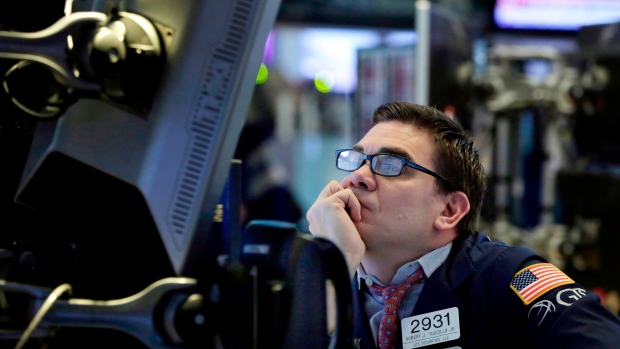Apr 3, 2018
TSX dips, Wall Street closes higher as tech stocks recover
Reuters

Wall Street's three major indexes staged a comeback to close around 1 per cent higher on Wednesday as investors turned their focus to earnings and away from a trade conflict between the United States and China that wreaked havoc in earlier trading.
After investors fled equities in the morning due to proposed retaliatory tariffs from China, their concerns about a potential trade war eased by the afternoon after Trump's top economic adviser Larry Kudlow said the administration was in a "negotiation" with China rather than a trade war.
Investors said they were comforted by the fact that any tariffs would not take effect immediately, if at all. Strategists also cited the S&P's bounce above a key technical support level and said they expect equities to rise further around the first quarter earnings season, due to start in mid-April.
"We're starting to feel that while markets hate uncertainty, Trump's bark is worse than his bite when it comes to trade," said Robert Phipps, a director at Per Stirling Capital Management in Austin, Texas.
"It's earnings that's going to lift us off this bottom. It wouldn't shock me if we chopped around sideways for a little bit before earnings season ... The trade stuff is really a side show. We're waiting for real economic data like the jobs report Friday and for earnings. For now it's going to be all about the technicals," he said.
The S&P opened below its 200-day moving average, a key technical level, but inched above it as the session progressed, and by afternoon was in positive territory.
The Dow Jones Industrial Average rose 230.94 points, or 0.96 per cent, to close at 24,264.30, the S&P 500 gained 30.24 points, or 1.16 per cent, to 2,644.69 and the Nasdaq Composite added 100.83 points, or 1.45 per cent, to 7,042.11.
The turnaround marked the first time the S&P had showed gains for two consecutive days since early March.
Despite big swings in stocks, trading activity in U.S. equity options was muted as expectations for strong corporate earnings quelled the urge to load up on contracts that benefit from a surge in market volatility.
The Cboe Volatility Index, the most widely followed barometer of expected near-term volatility for the S&P 500, closed down 1.04 points at 20.06.
The technology sector rose 1.4 per cent with only two of its stocks ending the day in negative territory including Facebook Inc, which was pummeled after news its chief executive would testify in Congress over a data privacy scandal. It too closed well off its session low with a 0.6 per cent drop to US$155.10.
Boeing was the biggest drag on the Dow due to its exposure to China, and ended the day well off its session lows with a 1 per cent decline to US$327.44 after falling as low as US$311.88.
Farm machinery company Deere & Co (DE.N) ended down 2.9 per cent at US$148.57 as it could be hurt by China tariffs if its customers' exports are curbed.
After being a laggard for much of the session, the S&P 500's industrials sector turned positive late in the day to close 0.4 per cent higher.
Advancing issues outnumbered declining ones on the NYSE by a 2.19-to-1 ratio; on Nasdaq, a 2.95-to-1 ratio favored advancers.
The S&P 500 posted one new 52-week high and eight new lows; the Nasdaq Composite recorded 40 new highs and 94 new lows.
Volume on U.S. exchanges was 7.04 billion shares, compared with the 7.3 billion average for the last 20 trading days.
CANADIAN STOCKS
Canada's main stock index pared earlier losses on Wednesday as investors grew less worried about trade tensions, but the TSX still posted its lowest close in nearly eight weeks as shares of financial and materials companies declined.
The Toronto Stock Exchange's S&P/TSX composite index ended down 16.39 points, or 0.11 per cent, at 15,164.37, its lowest close since Feb. 9.
The index had dipped below the 15,000 threshold earlier in the session.
The recovery from session lows came as Wall Street's three major indexes staged a comeback to close around 1 per cent higher. Investors turned their focus to earnings and away from a trade conflict between the United States and China that wreaked havoc in earlier trading.
Financials on the TSX fell 0.4 per cent, while the materials group, which includes precious and base metals miners and fertilizer companies, lost 0.8 per cent.
Crop nutrient producer Nutrien Ltd retreated (NTR.TO) 1.6 per cent to $57.70.
Six of the TSX's 10 main groups ended lower. The index posted two new 52-week highs and 15 new lows.
The largest per centage gainer on the TSX was Element Fleet Management Corp (EFN.TO), which rose 4.3 per cent, while the largest decliner was Prometic Life Sciences (PLI.TO), down 6.9 per cent.
Weed stocks were among the most active Canadian stocks by volume, including Aurora Cannabis (ACB.TO), which fell 5.6 per cent to US$7.62.







